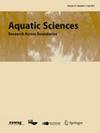Comparative analysis of contemporary and subfossil Cladocera assemblages with respect to lake utilisation and environmental factors
Abstract
Shallow lakes hold significant ecological importance, serving as habitats for various species and functioning as carbon sinks. In this study we investigated contemporary and subfossil Cladocera assemblages of a mixed-use (nature protection, agriculture and recreation) shallow oxbow lake. We examined the effects of utilisation on species variations and how these utilisations can affect Cladocera species. A total of 36 species were identified, from which ten were only found in the contemporary assemblage, with 35 belonging to the subfossil assemblage. The subfossil assemblage showed consistently higher species richness and abundance. The highest number of species in both assemblages was found in the protected area, which also exhibited the highest number of individuals for the contemporary assemblage. The Mantel test indicated a weak correlation between the assemblages collected. Non-metric multidimensional scaling revealed a clear separation between the agriculturally utilised section and other areas based on the composition of the contemporary assemblage. Furthermore, canonical correspondence analysis identified potential associations between specific chemical and physical variables and the observed variations in species abundances. These findings highlight the impacts of utilisation types and suggest environmental factors influence Cladocera distribution and abundance.

 求助内容:
求助内容: 应助结果提醒方式:
应助结果提醒方式:


